 W
WEthiopian cuisine characteristically consists of vegetable and often very spicy meat dishes. This is usually in the form of wat, a thick stew, served on top of injera, a large sourdough flatbread, which is about 50 centimeters in diameter and made out of fermented teff flour. Ethiopians eat most of the time with their right hands, using pieces of injera to pick up bites of entrées and side dishes.
 W
WThis is a list of Ethiopian and Eritrean dishes and foods. Ethiopian and Eritrean cuisines characteristically consists of vegetable and often very spicy meat dishes, usually in the form of wat, a thick stew, served atop injera, a large sourdough flatbread, which is about 50 centimeters in diameter and made out of fermented teff flour. Ethiopians and Eritreans eat exclusively with their right hands, using pieces of injera to pick up bites of entrées and side dishes. Utensils are rarely used with Ethiopian and Eritrean cuisine.
 W
WAbyssinian Kitchen is an Ethiopian and Eritrean restaurant in Portland, Oregon.
 W
WAframomum corrorima is a species of flowering plant in the ginger family, Zingiberaceae. It's a herbaceous perennial that produces leafy stems 1–2 meters tall from rhizomatous roots. The alternately-arranged leaves are dark green, 10–30 cm long and 2.5–6 cm across, elliptical to oblong in shape. Pink flowers are borne near the ground and give way to red, fleshy fruits containing shiny brown seeds, which are typically 3–5 mm in diameter.
 W
WBeer is the most popular industrial alcoholic beverage in Ethiopia with lager being the most consumed type of beer. In the rural sector the home-brewn talla or siwa is still dominant.
 W
WBerbere, is a spice mixture whose constituent elements usually include chili peppers, coriander, garlic, ginger, Ethiopian basil, korarima, rue, ajwain or radhuni, nigella, and fenugreek. It is a key ingredient in the cuisines of Ethiopia and Eritrea.
 W
WCoffee production in Ethiopia is a longstanding tradition which dates back dozens of centuries. Ethiopia is where Coffea arabica, the coffee plant, originates. The plant is now grown in various parts of the world; Ethiopia itself accounts for around 3% of the global coffee market. Coffee is important to the economy of Ethiopia; around 60% of foreign income comes from coffee, with an estimated 15 million of the population relying on some aspect of coffee production for their livelihood. In 2006, coffee exports brought in $350 million, equivalent to 34% of that year's total exports.
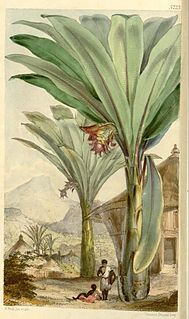 W
WEnsete ventricosum, commonly known as enset or ensete, Ethiopian banana, Abyssinian banana, pseudo-banana and false banana, is an herbaceous species of flowering plant in the banana family Musaceae. The domesticated form of the plant is only cultivated in Ethiopia, where it provides the staple food for approximately 20 million people. The name Ensete ventricosum was first published in 1948 in the Kew Bulletin, 1947, p. 101. Its synonyms include Musa arnoldiana De Wild., Musa ventricosa Welw. and Musa ensete J.F.Gmel. In its wild form, it is native to the eastern edge of the Great African Plateau, extending northwards from South Africa through Mozambique, Zimbabwe, Malawi, Kenya, Uganda and Tanzania to Ethiopia, and west to the Congo, being found in high rainfall forests on mountains, and along forested ravines and streams.
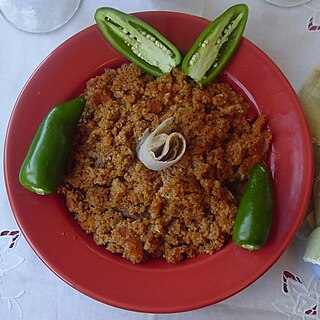 W
WFit-fit or fir-fir, , is an Eritrean and Ethiopian food typically served as breakfast. Fit-fit is served by preparing sauce and shredding injera or kitcha into pieces and mixing the two. It is generally made with shredded flat bread, spiced clarified butter, and the hot spice berbere. There are two main varieties of fit-fit depending on the type of flatbread being used: the sourdough injera and the unleavened kitcha.
 W
WFul medames, or simply fūl, is a stew of cooked fava beans served with olive oil, cumin, and optionally with chopped parsley, garlic, onion, lemon juice, chili pepper, and other vegetable, herb, and spice ingredients. Ful medames are traditionally made in and served out of a large metal jug. It is notably a staple food in Egypt and is considered a national dish, especially in the northern cities of Cairo and Gizah Ful medames is also a common part of the cuisines of many Arab, Middle Eastern, and North African cuisines.
 W
WGenfo, Ga’at, or Marca is a stiff porridge-like substance that is normally formed into a round shape with a hole in the middle for the dipping sauce, a mixture of butter and red peppers, or pulses such as sunflower, seed, nut and flax.
 W
WGored gored is a raw beef dish eaten in Ethiopia. Whereas kitfo is minced beef marinated in spices and clarified butter, gored gored is cubed and left unmarinated. Like kitfo, it is widely popular and considered a national dish. It is often served with mitmita and awazi.
 W
WGuizotia abyssinica is an erect, stout, branched annual herb, grown for its edible oil and seed. Its cultivation originated in the Eritrean and Ethiopian highlands, and has spread to other parts of Ethiopia. Common names include noog/nug ; niger, nyger, nyjer, or niger seed ; ramtil or ramtilla; inga seed; and blackseed.
 W
WHimbasha Ambasha is originally an Eritrean celebration bread that is slightly sweet. It is popular in Eritrea and became popular in Ethiopian cuisine later and is often served at special occasions. It is prepared in a number of varieties; however, the most distinctive flavoring is ground cardamom seeds.
 W
WInjera is a sour fermented flatbread with a slightly spongy texture, traditionally made of teff flour. In Ethiopia, Eritrea, and some parts of Sudan, injera is the staple; also eaten in other countries in East Africa, injera is central to the dining process, like bread or rice elsewhere. This food item is almost similar to South Indian dosa.
 W
WJebena is a traditional Ethiopian and Eritrean coffee pot made of pottery. It is also used in Sudan, and the coffee itself is called buna.
 W
WKitcha, , is a relatively thin unleavened bread typical of Ethiopian and Eritrean cuisine. It is generally made with wheat flour, water, and salt. It is cooked in a hot pan free-form until one side is cooked. It is then picked up and cooked on the other side. Slight burning on each side is often seen.
 W
WKitfo, sometimes spelled ketfo, is a traditional dish found in Ethiopian cuisine. It consists of minced raw beef, marinated in mitmita and niter kibbeh. The word comes from the Ethio-Semitic root k-t-f, meaning "to chop finely; mince."
 W
WKocho is a bread-like fermented food made from chopped and grated ensete pulp. It is used as a staple in Ethiopian cuisine in place of injera. In 1975 more than one-sixth of Ethiopians depended completely or partially on kocho for a substantial part of their food. It is eaten with foods such as kitfo.
 W
WLippia abyssinica, or koseret, is a species of flowering plant in the verbena family, Verbenaceae. It is endemic to Ethiopia but cultivated throughout tropical African countries. The specific epithet abyssinica derives from Latin and means 'of or from Ethiopia (Abyssinia)'.
 W
WMitmita is a powdered seasoning mix used in Ethiopia. It is orange-red in color and contains ground African bird's eye chili peppers, Ethiopian cardamom (korerima), cloves, and salt. It occasionally has other spices including cinnamon, cumin, and ginger.
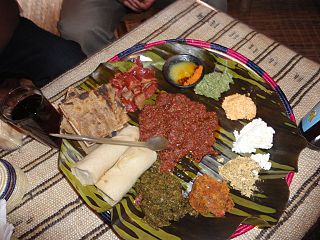 W
WNiter kibbeh, or niter qibe, also called tesmi, is a seasoned, clarified butter used in Ethiopian and Eritrean cuisine. Its preparation is similar to that of ghee, but niter kibbeh is simmered with spices such as besobela, koseret, fenugreek, cumin, coriander, turmeric, Ethiopian cardamom (korarima), cinnamon, or nutmeg before straining, imparting a distinct, spicy aroma. The version using vegetable oil instead of butter is called yeqimem zeyet.
 W
WQueen of Sheba is an Ethiopian restaurant in Portland, Oregon.
 W
WRhamnus prinoides, the shiny-leaf buckthorn, is an African shrub or small tree in the family Rhamnaceae. Commonly referred to as "gesho" it was first scientifically described by French botanist Charles Louis L'Héritier de Brutelle in 1789.
 W
WA samosa is a South Asian fried or baked pastry with a savory filling like spiced potatoes, onions, peas, chicken and other meats, or lentils. It may take different forms, including triangular, cone, or half-moon shapes, depending on the region. Samosas are often accompanied by chutney, and have origins in medieval times or earlier. Samosas are a popular entrée, appetizer, or snack in the local cuisines of South Asia. Due to emigration and cultural diffusion from these areas, samosas today are often prepared in other regions.
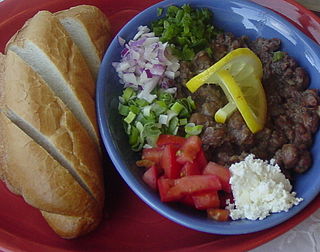 W
WShahan ful, simplified to ful, is a dish common in Sudan, South Sudan, Somalia, Ethiopia and other parts of the Horn of Africa, which is generally served for breakfast. Believed to originate from Sudan, it is made by slowly cooking fava beans in water. Once the beans have softened, they are crushed into a coarse paste. It is often served with chopped green onions, tomatoes, and hot green peppers, as well as yogurt, feta cheese, olive oil, tesmi, berbere, lemon juice, cumin, and chili pepper. It is typically eaten without the aid of utensils accompanied with a bread roll. It is popular during the Ramadan season and during the various Lents.
 W
WShiro, shiro wat, or tsebhi shiro is an East African stew. Its primary ingredient is powdered chickpeas or broad bean meal and often prepared with the addition of minced onions, garlic and, depending upon regional variation, ground ginger or chopped tomatoes and chili-peppers. Shiro is served atop injera or kitcha. Tegabino shiro is a type of shiro made from heavily spiced legume, chickpea, field pea, or fava bean, oil, and water. It is brought bubbling to the table in a miniature clay pot or shallow aluminum pan. It is often consumed with dark or sergegna injera.
 W
WSiwa, Amharic: ጠላ, is a beer originating from Tigray. Traditionally home-brewed, siwa remains locally popular during social events, after (manual) work, and as an incentive for farmers and labourers. Thousands of traditional beer houses straddle the Tigrayan urban and rural landscapes.
 W
WEragrostis tef, also known as teff, Williams lovegrass or annual bunch grass, is an annual grass, a species of lovegrass native to the Horn of Africa, notably to modern-day Ethiopia. It is cultivated for its edible seeds, also known as teff. Teff was one of the earliest plants domesticated. It is one of the most important staple crops in Ethiopia and Eritrea.
 W
WTihlo is a dish from the historical Agame province in Tigray that consists of barley dough balls covered with meat and berbere based sauce often served as a snack. Tihlo is commonly consumed as a side dish or snack, especially in Tigrayan communities.
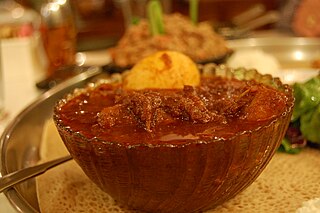 W
WWat or Wot or Tsebhi is an Ethiopian and Eritrean stew that may be prepared with chicken, beef, lamb, a variety of vegetables, spice mixtures such as berbere, and niter kibbeh, a seasoned clarified butter.
 W
WZigni or kai wat is a popular Eritrean and Ethiopian stew made from meat, tomatoes, red onions and Berbere spices. The meat can be beef, lamb, goat, or chicken and usually placed on a plate of injera, a type of unleavened bread made from teff flour. It can be eaten for lunch or dinner. The dish requires a relatively long amount of time but not a lot of active effort to make. The traditional recipe can take as long as five to six hours to prepare. As such, it is sometimes reserved for special occasions. The Berbere spices can make the zigni spicy and give it a red color.